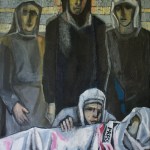
n honour of Mahmoud Darwish’s 84th birthday, we examine how the Palestinian wordsmith continues to inspire creativity in the region, even after his death
Culture Rawaa Talass 12 March, 2025
March 13 marks the 84th birth anniversary of one of the Arab world’s most influential literary voices: Mahmoud Darwish. Born in 1941 and raised in a village home void of books, the Palestinian wordsmith rose to become his homeland’s national poet.
His passionate prose discussed the themes of loss, exile, dispossession, and resistance — loaded topics that captured the hearts of Arab populations but also led to imprisonment, where he continued to write.
Throughout his eventful career, Darwish authored over 30 books of poetry, which have been translated into various international languages.
Describing himself once as a “carpenter of words,” Darwish’s classical Arabic poetry still hits a nerve with people today, amidst ongoing injustices endured by Palestinians and Arabs, and that is precisely what makes his writing relevant.
In 1964, as a young man in his early twenties, he famously wrote in his poem Identity Card:
“Write it down!
I am an Arab.
You have stolen my ancestors’ groves
And the land we cultivated
I and all my children
Leaving nothing for us and all my grandchildren
Except these rocks
Will your government take them
Like people say?Therefore,
Write down on the top of the first page:
I do not hate people
And I do not steal from anyone
But if I starve
I will eat my oppressor’s flesh
Beware, beware of my starving
And my rage.”
Through his poignant prose, Darwish, who spent most of his adult life in exile, has also inspired multi-generational Arab artists in both music and visual art for decades.
In honour of his 84th birthday, we examine how five visual artists from the region have based their works on the poet, who died in 2008 but whose timeless writing continues to move readers today.

Portrait of Mahmoud Darwish by Abed Abdi, 1962
Executed on paper with charcoal pens, here is a rare portrait of Darwish gazing away from the viewer in a pensive mode. This image was created in a sensitive manner by the Palestinian artist Abed Abdi, who was friends with the poet.

At the time during the early 1960s, Abdi was at the beginning of his artistic career. Darwish was also a young man, working for Al-Ittihad Newspaper and Al-Jadeed Magazine in the Palestinian coastal city of Haifa, a place of significance for Darwish, since he spent part of his youth there.
“Cities are smells… Haifa is the smell of pine and wrinkled sheets,” he once wrote.
According to Abdi, he asked Darwish if he could produce his portrait as a sign of their friendship. After all these years, the artist owns the artwork until this day.

source: The New Arab



















